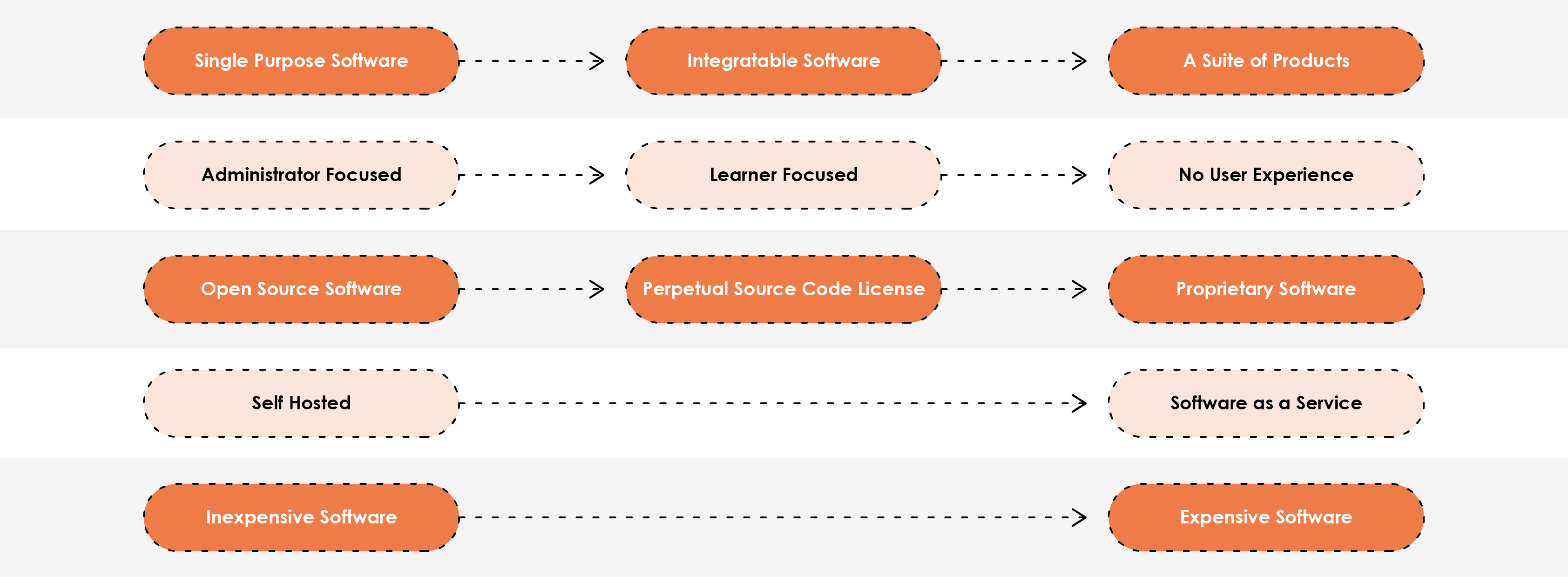Tim Martin, LTG’s Chief Innovation & Product Officer, based in Nashville, TN., gives an in-depth explanation of why we’re buying Open LMS.
We really believe that there is no single LMS that serves all customers, and we want to have the right LMS for almost every customer. Open LMS serves a very different buyer than does PeopleFluent Learning, and we want to serve both.
––––––
I’ve driven seven cars in my life. The third one came from {some other brand} and told me that henceforth I would drive Hondas. And there’s a reason for this. Hondas suit my sensibilities, my values. In the automotive domain, those sensibilities might include luxury, performance, value for money, or even attitude. In my case, there’s a fit and finish to Honda that I like, and I’ve come to view the touches Honda values as luxury. Yes, I am aware there are fancier cars that exist, but they don’t feel more valuable to me, and that means that I buy Hondas.
It turns out, Learning Management Systems are a little like cars. There is no way to build one LMS that suits every organization’s needs. And this is one of the reasons there are so many LMSs in the market. When I worked at Rustici Software, we regularly marveled at every new LMS that walked in our door seeking help with SCORM. LMSs can differentiate in so many different ways… I’ll posit five here.

Each of these could be an article in its own right, so I’ll do a quick version of one here to help it make sense for the rest of the discussion. Take the first…
Nobody really wants to be identified as single purpose these days. That end of the continuum is hard to buy from, so I’ll start at Integratable Software. Cornerstone On Demand fits this bill when stacked up next to the “Suite of Products” representatives, Workday and SAP. When a company buys an LMS from Workday or SAP, they can reasonably expect that the integrations will be well-formed, tested and complete. The benefit to the customer comes from that integration, but they are likely to give up a particular fit with their business or needs. Cornerstone, on the other hand, has to compete on its individual merits. It may have more functionality and a better ability to fit its software to the needs of its learning or talent customers than a full suite does. This is to say… the ends of any one continuum are not bad and good… they are fit for the needs of a given organization.
Consider the second continuum. It is largely impossible for an LMS to be both profoundly deep in functionality and profoundly simple to consume as a learner. Yes, every system wants to be both deep and simple, but those concepts conflict. LTG currently offers solutions that span this continuum elegantly. PeopleFluent Learning is incredibly deep, offering sophisticated learning path and assignment options in addition to intricate extended enterprise capability. Bridge Advanced Video (the Learning Experience Platform we offer) is focused squarely on the learners’ experience, both in delivery of content and capturing it from the learners. It prioritizes something different than PeopleFluent Learning. In the most extreme, there are LMSs that attempt to ‘disappear’: Some LMSs are even delivering content directly in the context of Salesforce or Slack (systems from other domains).
And all of that is prologue for… why would LTG buy another LMS company?
LTG lacked options for customers on one end of an important continuum.
The Open Source Software ➡️ Proprietary Software continuum is a binary one for many buyers. The reasons vary.
- OSS suits tinkerers. Some organizations want to make their application look a certain way, or try customizing it, or combine it with other software they control. These groups can find that OSS is much better suited to this than proprietary software.
- Some believe OSS is more secure precisely because one can see the fashion in which it was made. (Others take the opposite view and shouldn’t be on this end of the continuum.)
- Some organizations are required to use or buy OSS rather than license software they can’t own.
- Universities often have lots of competent, low-priced labor (students etc) that can extend and integrate OSS to great effect.
In total, it all comes down to the fact that different organizations have different parameters and needs.
And we want to serve those customers.
We will continue to offer Open LMS in managed hosted and SaaS options. We will continue to participate in the evolution of Moodle, an open-source LMS. And yes, we will leverage the capability we have across LTG to enhance the offering around Open LMS. As soon as we’re able, we’ll start offering integrations with Gomo, Rustici’s Engine, Watershed, and services we offer throughout LTG.
Acquiring Open LMS is exciting to us in its own right, but we don’t anticipate stopping there. We believe that consolidating some of the Moodle providers from around the world will allow us to operate more efficiently and more effectively leverage every bit of energy we put into Moodle itself and the products and services we arrange around it. We’re excited to do more.